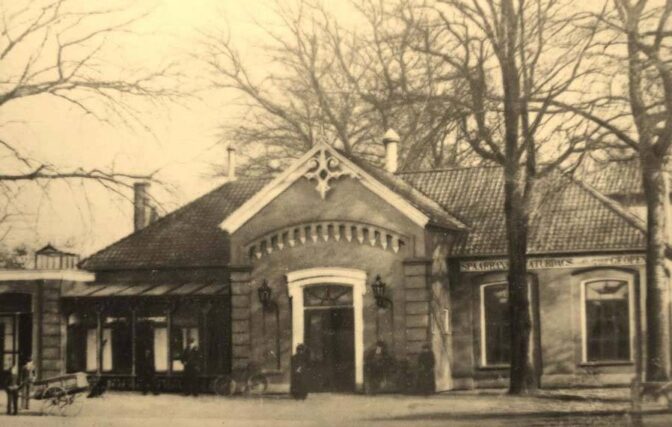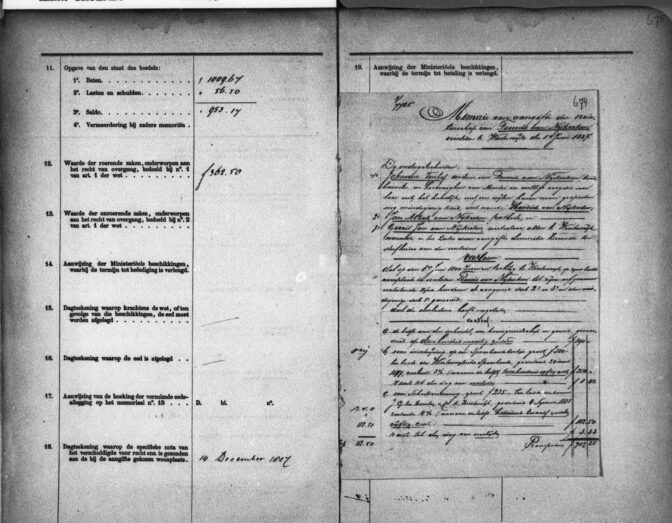While researching my third great-grandfather Teunis van Nijkerken, I discovered he owned quite a bit of capital when he died in Winterswijk on 1 June 1887. His death duties file indicated he and his wife Johanna Vonhof owned over 2,000 guilders in assets, including 500 guilders in a bank account, and about 700 guilders in money lent to others.1
By the time Johanna Vonhof died on 24 July 1889, the value of the estate had shrunk to 1,700 guilders, which included almost 600 in the bank account and the same 700 guilders in money lent to others.2
Wait a minute, a bank account? I did not even realize Winterswijk had a bank that early!
I followed up with some literature research and found out that Winterswijk has had a bank since 1868. It started with 39 clients and a joint capital of just over 1,000 guilders. By 1880, 421 clients had deposited over 30,000 guilders. In 1900, the number of clients had grown to 1,350, depositing almost 300,000 guilders.
The bank started in the community building the “Eendracht.” Once per week, on Saturday evenings between 6 and 7 PM, the bankers would be in session to receive clients. Privacy was impossible in the small room. The bank allowed for deposits as small as 15 cents. Among its clients were many factory laborers, who deposited their wages and then withdrew the balance when they married and wanted to buy a house, the bank providing a loan for the remainder under favorable conditions.3

“Eendracht” building, with the bank sign on the right. Credits: Oud Winterswijk (public domain)
That Winterswijk bank later merged with another bank, that merged again, and again, and again. The records of the Winterswijk bank ended up among the records of the Bank of Central and Eastern Netherlands, and are now kept at the Historisch Centrum Overijssel in Zwolle, in a different province than Winterswijk.4
Among the surviving records for Winterswijk are deposit books, balance books, and lists of people banking there. I bet there are several other ancestors of mine in those records. I put this on my list of records to look for, the next time I’m in Zwolle.
Teunis van Nijkerken was a bricklayer who did not own real estate. The only glimpse I had into his financial situation was the death duties file created after his death. Thanks to these bank records, I may learn more about his circumstances earlier in his life.
This example demonstrates that when we find records for our ancestors, we should ask ourselves which organizations or persons would have created records about them. In this case, a reference to a bank account led me to discover a whole new record group I knew nothing about.
Sources
- Groenlo office, death duties files, register IV, records of succession duties, 1887, first half year, record 3/7725, Teunis van Nijkerken; call no. 88, “Memories van Successie, Kantoor Groenlo,” record group 0028, Gelders Archief, Arnhem; finding aid and scans, Gelders Archief (http://www.geldersarchief.nl : accessed 8 August 2020).
- Groenlo office, death duties files, register IV, records of succession duties, 1889, second half year, record 3/928, Teunis van Nijkerken; call no. 93, “Memories van Successie, Kantoor Groenlo,” record group 0028, Gelders Archief, Arnhem; finding aid and scans, Gelders Archief (http://www.geldersarchief.nl : accessed 8 August 2020).
- Willem Peletier, “De Nutsspaarbank,” 150 jaar Department Winterswijk van de Maatschappij tot Nut van ‘t Algemeen, 23-30.
- “Bondsspaarbank Centraal en Oostelijk Nederland en Voorgangers,” finding aid 1312, Historisch Centrum Overijssel (https://historischcentrumoverijssel.nl : accessed 8 August 2020).



Dit is inderdaad een heel interessant onderwerp. En voor een metselaar een behoorlijk hoog bedrag. Is die metselaar wellicht een voorouder van de kruidenier van Nijkerken, hoek Plataanlaan-Vredenseweg en hebben ze dat kapitaal mogelijk geïnvesteerd in de zaak? Ik begin te vermoeden, dat mijn opa misschien ook geld heeft ingelegd/gespaard bij genoemde bank, want hij kocht destijds (ca 1920) een stuk grond aan de Plataanlaan (heette toen geloof ik nog Dorpbuurt) en bouwde daar een huis met een stal erachter. En dat was ook een behoorlijke investering voor een fabrieksarbeider (wever).